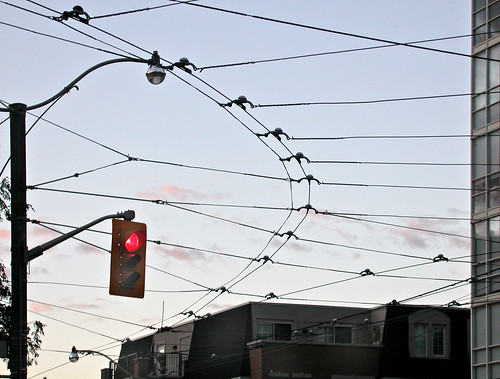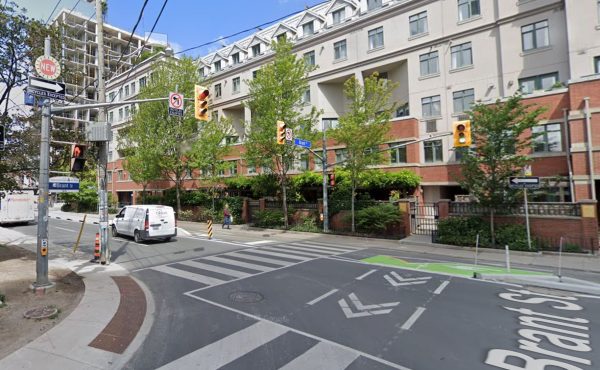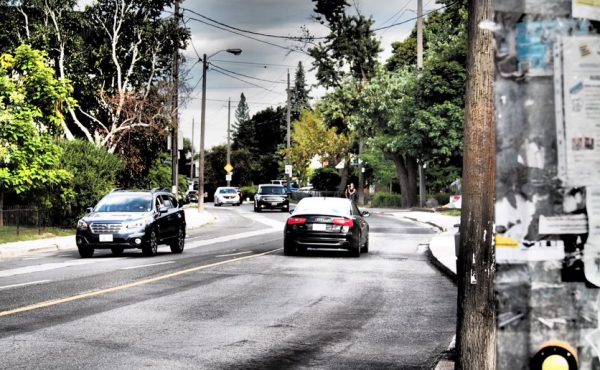
Intersections are inherently a competition for space and time. In many places in the world, intersections are still governed largely by the assertiveness of the participants. Crossing the street in many parts of Italy drivers will not stop unless you walk out onto the street. In orderly Toronto, the nature of intersections has been heavily institutionalized and regulated; we expressly decide which parties will have the priority at intersections in the city based on the importance we place on different modes of transportation.
While it is easy to argue that our society gives this priority to cars, Toronto is taking steps, albeit small ones, to shift its priorities and institutionalize intersections where transit and pedestrians are the primary focus.
Toronto began gradually implementing signal priority for streetcars along Queen Street in the mid 1980s and since then has expanded the program to 332 intersections across the city. You will likely experienced — possibly unknowingly — a handful of signal priority intersections if you travel on the Queen, King, College, St Clair, Dundas, Gerrard, Bathurst, and Spadina streetcars or Dufferin, Jane and Finch West buses. The city has the goal of implementing priority along one route every year and is currently working on Finch East. Bruce Zvaniga, at Transportation Services filled Spacing in on some of the details of how the signals work for transit vehicles.
As a streetcar (or equipped bus) approaches an intersection it is picked up as part of the control system’s loop. Upon detecting the transit vehicle, the system will hold its right of way for two second intervals, until the vehicle has passed. This can last a maximum of 30 seconds. If the vehicle is facing a red light the system can initiate the pedestrian countdown and shorten the opposing green up to 15 seconds.
The biggest impediment to having transit vehicles soar through a continuous stream of green lights is the pedestrian signals, which must give enough time for people to cross safely. The city is also working on improving pedestrian priority; something of particular interest in light of January’s tragic spree of pedestrian deaths. The intersection of University and Adelaide is currently hosting a test program of pedestrian signal priority in which pedestrians are given a head start of cars. The idea is to allow pedestrians out into the intersection before traffic starts, in order to better establish their presence. Such systems are already well used in Montreal. The city plans to implement similar schemes at 4-5 other intersections this year in situations where there is a large amount of left hand turns.
As for Transit City vehicles, officials are currently working out what kind of signal priority will be implemented. The city says that the scheduled nature of the new lines will likely force a new set-up. Garry Carr, a traffic engineer with the TTC who is working on the details of the new LRT lines, told Spacing that Transit City vehicles will likely have enhanced priority over what is currently given to the legacy streetcar network. LRTs will likely have GPS based sensors that detect when the vehicle has left the previous intersection so that the next interchange can be timed accordingly. Carr says that such a system may also be used to slow vehicles down when they are running ahead of schedule (maybe preventing the need for impromptu coffee breaks). It also should be noted that the design for the new lines currently features three-metre wide pedestrian waiting areas to enhance safety and comfort (platforms on Spadina are 2.4 metres wide).
While transit riders may be weary of the tangible improvements of priority at intersections, Carr insists that Toronto’s signal priority program is amongst the most aggressive in North America. At the city’s already crowded intersections the impediments to a system that would allow for better flow of transit vehicles are great. Traffic must kept flowing, pedestrians must be given sufficient time and everything must be done in a way that follows the conventions of what people are expecting; an important aspect of safety.
At the city’s intersections, the collective priorities of our city are laid bare. Who we direct priority towards reflects not only on our values, but on the course we are setting for our future.
Photo by Kevin Steele




16 comments
I have heard, but never had confirmed, that emergency vehicles have signal priority at some intersections as well. I have noticed what seems to be a change in the light cycle at Yonge and Montgomery as fire trucks leave the station just to the west of this intersection. Can anyone verify whether or not emergency vehicles have control over traffic lights?
I’ve noticed the same signal priority for fire trucks at Queen and Niagara. There’s a fire station just around the corner on Claremont.
From what I talked about with transportation services it sounded like emergency vehicles also use a priority system. Not sure about the details though.
I’ve read on the Stevemunro.ca blog that traffic priority hasn’t in fact been used on Spadina to speed the 510 streetcars – due to unduly delaying traffic on cross streets such as College, Dundas & Queen.
So much for faster, prioritized streetcar service eh!
Apparently Toronto Traffic engineers are so worried about ‘traffic chaos’ that they’ve stimied all TTC attempts to enact traffic priority since the Spadina 510 route opened in teh mid 90s.
An effective transit (& pedestrian) priority system is sorely needed in Toronto, and would go a long way in speeding the journeys of us long suffering transit riders.
The other problem is that left turn automobiles (even single-occupancy) are given priority before streetcars (even standing-room only streetcars). If there is a streetcar coming up or at the intersection, they should be given first go. That is, red in ALL directions so that streetcars and proceed first.
@W.K. Lis I asked the city about this and they said the reason left hand turns still went first is because it follows the convention of what drivers and pedestrians are expecting. They did however say that they were looking at changing this on the Transit City lines.
How does priority play into station stop location? I recall most Toronto stops being before the traffic light. Automatic priority sensing makes much more sense if the stop is located after the light, correct? Or is it better if the stop is before the light, because then the operator can use a red light to unload/load, and only manually call for priority when ready to proceed?
One sidenote on light timing — you haven’t really experienced the thrill of coordinated signal timing until you’ve ridden the “green wave” on a Manhattan avenue late at night. When those greens all fall in line at a 35-mph clip and you travel 100 blocks/100 traffic lights without touching the brakes, it’s quite a guilty rush. Doesn’t do a damn thing for buses, but wow does it flush hordes of cabs through the streets.
There may well be some tweaking/advance on other roads but putting Spadina into that list is suspect. The streetcar is at a red; then there’s an advance left hand turn across the streetcar path, then the light turns green, and then the streetcar stops on the other! side of the street for passengers/exits.
That’s delay, not any advance, but the Metrocrats and weak politicians (most of whom are still around in one party/level or another) couldn’t manage to find room on wide Spadina for bike lanes either…
You’ll find this documentary highly fascinating, and the first of many to come that will change transit:
http://www.pbs.org/newshour/bb/transportation/jan-june10/detroit_02-08.html
Please share with everybody, and don’t forget the gals!, and the public, and the Toronto TTC riders!
The problem with the current transit control system is that it does not take into account the expected delay at an intersection. I saw a perfect example last night at Bathurst and Dundas. The northbound streetcar arrived at the stop (which is on the south side of Dundas) and the “hold red” kicked in. But there was a real crowd of people getting on the bus, so when it was just ready to pull away, the 30 second hold was over, and then it had to sit through a full red. If there had been no priority, the red cycle would have been nearly done by the time the streetcar was ready to go.
I think it is nearly impossible for an automated system to get it right. The transit control should be initiated by the drivers, calling for early greens or delayed reds as needed to keep their vehicles moving.
Here’s an outside-the-box idea. A big impediment to effective transit priority on wide streets is the long time required for pedestrians to clear the intersection. What if we did not require the pedestrians to clear the intersection? What if we simply separated vehicle and pedestrian signals?
Here’s how it would work:
1. Transit vehicle approaches an intersection with a far-side stop. The light is red.
2. 20 seconds before reaching the intersecton the driver requests a green light.
3. On the cross-street, the traffic light immediately goes yellow, and the walk signal goes to the flashing hand. Pedestrian light count-down is suspended.
4. The driver slows down and rings his bell or honks his horn to alert pedestrians he is not stopping.
5. Pedestrians clear the path of the transit vehicle. Since this is only a single lane, it doesn’t take long.
6. The cross-street traffic light goes red.
7. The transit signal goes green, but the through street traffic light remains red. (The pedestrian signal, on the other hand, should go green.)
8. The transit vehicle slowly goes through the intersecton.
9. Pedestrian light count-down for the cross street resumes, and pedestrians clear the intersection.
10. The cross street pedestrian light goes red.
11. The through-street traffic light goes green. (The through street pedestrian signal is already green.)
I agree with Laurie’s first comment, but her second, although well-meaning, is flawed. It’s true that our “transit priority” signals aren’t smart enough to deal with all traffic circumstances. If a transit vehicle falls behind schedule, crowds gather at each of the stops creating loading delays that would force the bus or streetcar to idle at every red light, despite the existence of priority signalling.
In Laurie’s example of the farside stop, how will this work in mixed traffic where there’s a queue of personal vehicles waiting at the red, some of which need to turn left? With proper foresight and design, it is possible to place a sensor just beyond the platform at a farside stop. Once the bus or streetcar has finished loading, it trips the sensor and prioritzes the signal ahead as it is travelling toward the next intersection, giving pedestrians enough time to complete their crossing. To improve transit right-of-ways like Spadina, St. Clair, Queen’s Quay and our future LRT lines, the city’s traffic department must change their policy to allow at least one streetcar through the intersection before left-turning vehicles. In this scheme, pedestrians still have to wait for left-turning vehicles to clear the intersection. A better solution for both pedestrians and transit is to design intersections that eliminate left-turns, forcing vehicles to make three right turns or a “Michigan Left”. The latter incorporates boulevards that can improve the streetscape as a whole.
Marc, that is a valid criticism. I was visualizing this approach in streets where transit vehicles have their own right of way, so that left-turners wouldn’t be an issue. I agree that it would be a good idea to ban left-turns on streetcar routes, and in places where the bus is likely to be in the left hand lane.
St. Clair Avenue West used have no left turn lanes. Left turners had to share turning with the streetcars. Now the left turners not only got their own left turn lane, but their own priority signals before everyone else. So much for transit priority.
To make things worse, green arrows for the left turners and streetcars can be confused. Instead of using transit signals used in Europe and in the United States, they use the very same signals as the rest of the traffic. That must be why there are collisions (not accidents) when left turners cross the path of streetcars, because they confuse the streetcar’s arrow with their left turn signal.
W.K., yes we absolutely should have transit signals like in Europe, that won’t confuse drivers!
I read recently how the St. Clair streetcar drivers are slowing down at intersections because they are afraid car drivers won’t suddenly left turn in front of them. This would be so easy to fix! It would just take a few thousand dollars to make a multi-million dollar dedicated right-of-way faster and safer.
Traffic Services got back to us with more information regarding priority for fire trucks. Here is what they said:
“… Toronto Fire Services do have traffic signal pre-emption at 51 intersections in the city … usually it’s the first (one or two) intersection(s) they encounter as they leave a firehall … the strategy is to clear the road in front of the firehall so that the trucks are not blocked by a queue of stopped cars in gaining access to the roadway.”